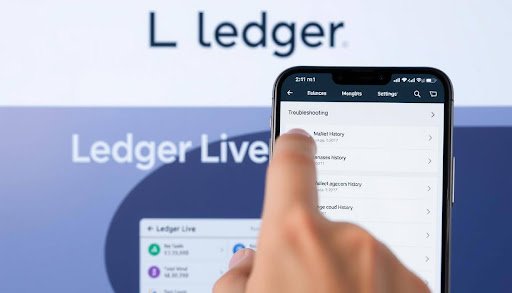Got a problem with Ledger Live? This guide helps fast. It shows how to fix your secure crypto app quickly. You’ll be back to checking your crypto wallet, tracking digital assets, and monitoring investments without any hassle.
This piec focuses on common issues reported by U.S. users. These problems are also talked about in Ledger’s resources and community forums. You might face errors like “Dependency missing when installing the application,” “Javascript Heap Out Of Memory,” or “‘node:path’ dependency missing.” These errors could come from issues with app dependencies, low memory limits in Node, or needing a newer version of Node.
Some might see HTTP 403 errors when adding apps like Ethereum. Reasons may include Cloudflare checks, server issues, IP rules, or old sessions. Fixing these can be as simple as clearing cache, updating Ledger Live, or waiting it out. Sometimes, using third-party tools like MyEtherWallet helps too.
We’ll start with quick solutions and dive into more detailed fixes if needed. Learn when to restart Ledger Live, change USB cables or ports, and reach out to Ledger support. We aim to get your balances updated and secure your storage quickly. Let’s make Ledger Live your go-to for managing digital assets and crypto.
Table of Contents
ToggleKey Takeaways
- Focus on quick wins first to stabilize Ledger Live and keep a secure crypto app experience.
- Dependency errors often point to version or memory limits; updates can resolve them fast.
- HTTP 403 issues may relate to Cloudflare, IP controls, or downtime—retry after clearing cache.
- USB cable and port changes can fix device recognition in seconds.
- VPN or proxy settings can block services; disable them if connections fail.
- When outages occur, wait and retry; check status updates and try again later.
- Escalate to Ledger support if your device remains unrecognized after basic checks.
Common Issues Users Face with Ledger Live
Users want a glitch-free experience with blockchain tools, but even the best ones have problems. When Ledger Live has issues, it can mess up managing cryptocurrencies and updating portfolios in real-time. Quickly understanding common errors lets you fix them fast.
Ledger Live ensures safe setup, syncing accounts, and tracking assets over networks. However, it might show warnings due to server issues, stored data, or app updates. We’ll link these problems to their causes, keeping your dashboard running smoothly.
Error Messages and Notifications
While installing Ethereum or similar apps, users may encounter HTTP 403 errors. These suggest limits on access, flagged security, or server settings. Sometimes the problem is outdated sessions, IP blocks, or mismatched app versions.
After updating, you might see errors about missing dependencies. Alerts like “Dependency missing when installing the application” point to incompatible versions or missing modules. These can halt installations or leave app catalogs incomplete.
If these warnings keep showing up, they can slow down managing cryptocurrencies and updating portfolios. Sorting errors by their type can show if they’re caused by server loads, data storage issues, or old software.
Connection Problems with Ledger Devices
Sometimes, Ledger devices aren’t recognized, or installations stop halfway. This can be due to bad USB cables, unreliable ports, or VPNs blocking access. Problems in the network infrastructure might also prevent devices from connecting properly.
Switching to a new cable and port often solves recognition issues with Ledger Nano S or X. Outdated software can cause other problems, like missing apps or sync issues in Ledger Live.
If there’s trouble linking devices, you might see a dashboard that won’t update, delayed balances, or transactions that won’t go through. These problems interrupt managing cryptocurrencies and timely portfolio updates until connections are fixed.
Quick Fixes for Common Ledger Live Problems
These fast steps solve most hiccups with the Ledger Live app download and get you back to secure crypto storage. Try them in order to restore your crypto wallet dashboard and keep real-time portfolio updates flowing.

Restarting Ledger Live
Close the app fully, then relaunch it to refresh your session. A fresh start often clears expired IDs that trigger 403 errors and restores requests to Ledger servers.
If the app still stalls, restart your computer. This can reset USB drivers and help Ledger Live recognize your Ledger Nano S or Ledger Nano X again.
Updating Ledger Live to the Latest Version
Install the newest release to fix interface bugs and connection issues. Move to the current desktop app for a better experience if you’re still on the old Chrome extension.
After the update, reopen the crypto wallet dashboard to confirm that accounts sync and real-time portfolio updates resume as expected.
Checking Internet Connection
Toggle off any VPN or proxy and test another network. Some routes can cause 403 responses or timeouts with Ledger services.
If there’s known downtime for a chain or service, wait a bit and retry. Stable internet is key for the Ledger Live app download, app installs, and secure crypto storage.
Reconnecting Your Ledger Device
Swap the USB cable for a high-quality one and try a different USB port. This resolves most detection problems with Ledger Nano devices.
Unplug, relock the device, and reconnect. Once detected, you can install apps, view your crypto wallet dashboard, and see real-time portfolio updates without delay.
Advanced Troubleshooting Techniques for Persistent Issues
When simple solutions fail, take a closer look before giving up on Ledger Live. Our goal is to fix a reliable blockchain tool. This helps keep your digital assets well-tracked for managing your cryptocurrency portfolio. Begin with safe cleanup steps, then try a comprehensive update, and seek help if problems don’t go away.
Clearing Cache and Data
Start by opening Settings, then tap the gear icon. Head over to the Help tab, choose Clear Cache, and confirm to restart. This step often fixes error 403, which can happen from bad cookies, old sessions, or wrong requests. It’s useful if Ethereum or other apps won’t install right because of cached errors. After restarting, Ledger Live makes new data connections, which usually fixes tracking and makes managing your cryptocurrency easier.
Reinstalling Ledger Live
If clearing the cache doesn’t work, then fully remove and reinstall the app to update its parts. This solves issues from old and new app versions not working together. People who make their own setups should use Node 16 or newer for the right support and fix memory errors if they happen. For most, reinstalling quickly makes Ledger Live reliable again and avoids complicated problems.
Contacting Ledger Support for Help
If your device won’t connect, or if you think the servers are overloaded, try again later before reaching out. Ledger’s support can only be reached online since they don’t have a phone service. If new devices won’t connect or old ones often fail, it’s time to ask for more help. Meanwhile, if you can’t get into Ethereum due to error 403, use another trusted service until everything works right. Following these steps ensures you can manage your cryptocurrencies well and keeps your tracking tool working.
FAQ
Why am I getting HTTP 403 errors when installing Ethereum or other apps in Ledger Live?
A 403 error means the server did not let your request through. This could be because of security checks by Cloudflare, the server being down (like what happened with Ethereum Classic), rules based on your IP address, sessions expiring, or issues with stored data. To fix this, try exiting and reopening Ledger Live, clearing the cache under Settings > Help, making sure you have the latest version, not using a VPN/proxy, or trying a different network. If the problem doesn’t go away, try again in a few hours. You can also use MyEtherWallet with your Ledger device as a temporary solution until Ledger Live works again.
How do I fix “Dependency missing when installing the application” in Ledger Live?
This problem usually comes up when syncing or updating from an old version of Ledger Live, indicating that some parts are missing or conflicting. To solve this, update Ledger Live first. If that doesn’t work, uninstall Ledger Live completely and then reinstall it. This refreshes the system. For those who know their way around tech and build from the source, make sure your setup is up to date before trying again.
What causes “Javascript Heap Out Of Memory” in Ledger Live operations?
This error is due to Node’s memory limit, which is around 1.5 GB, during big tasks. Most users can fix it by reinstalling the latest Ledger Live. If you’re building from the source, you can let Node use more memory and try the task again. Ensure your build is current before taking further steps.
Why do I see “‘node:path’ dependency missing” errors?
The ‘node:path’ module needs at least Node 16 to work. Regular users should reinstall the latest version of Ledger Live. Developers working from the source need Node 16 or newer. Once the correct version is in place, restart and check if the problem is gone.
Ledger Live doesn’t recognize my Ledger Nano S or Nano X. What should I do?
Start by closing Ledger Live and turning your computer off and on again. This resets the USB drivers. Change your USB cable for a better one and try different USB slots. Some cables don’t last long, and these gadgets can be choosy. Turn off any VPN or proxy and update Ledger Live. If Ledger’s servers are too busy, wait a bit and try again. If nothing works, especially with new or old devices, it’s time to reach out to Ledger Support on their website.
Conclusion
Ledger Live is a reliable tool for managing your digital assets, but like any software, issues can arise. Most problems—whether HTTP 403 errors, missing dependencies, or device connection issues—can be resolved quickly with simple steps like restarting the app, clearing cache, updating Ledger Live, or swapping USB cables. For more persistent issues, reinstalling or reaching out to Ledger Support ensures you stay on track. By following this troubleshooting guide, you can restore smooth operation and keep your crypto portfolio safe and accessible.




